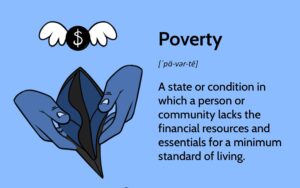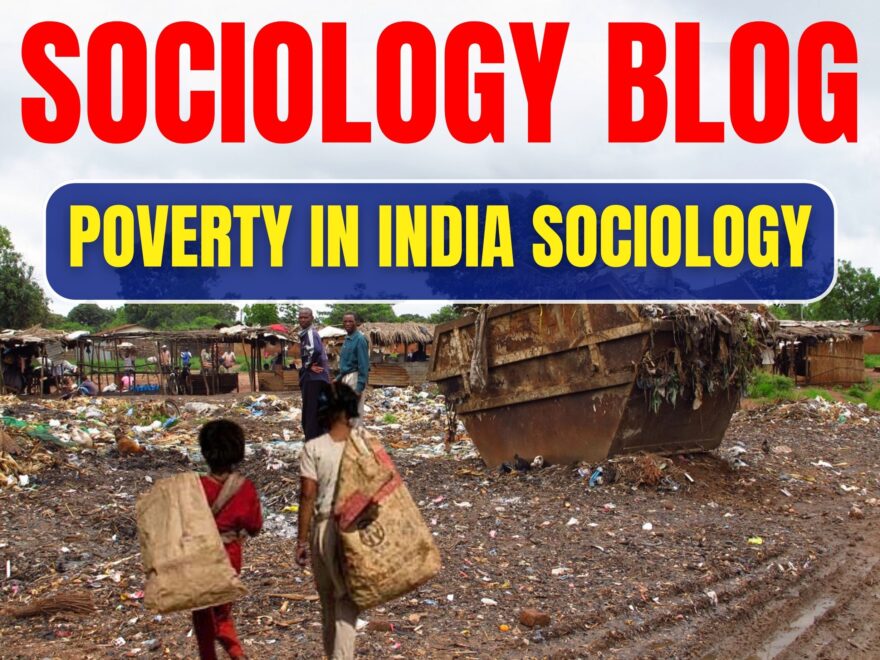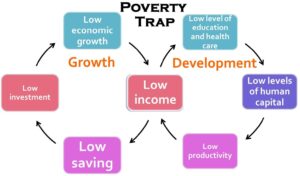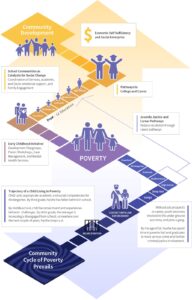Poverty in India Sociology
(Relevant for Sociology Optional for Civil Services Examination)
Paper 1: Stratification and Mobility
Paper 2: Rural and Agrarian transformation in India, Challenges of Social Transformation

Poverty
“In India the generally accepted definition of poverty emphasises minimum level of living rather than reasonable level of living.”
RUDRA DUTTA
- Poverty is a level of living that is so low that inhibits the physical, mental, social, cultural, economic development of the individuals or the groups. The problem of poverty in India after Independence can be described in terms of the social classes, castes or groups affected with poverty in rural and urban areas.
- The word “pauperism” is used to denote extreme poverty. It describes a category of people who are unable to maintain themselves. In recent times there are many dimensions that are considered in looking at poverty. It is no longer seen as purely an economic phenomenon. It is now realised that there are sociological, political, psychological and geographical reasons as well as attitudes or value systems that need to be considered to understand poverty.
- In dealing with poverty one is not only concerned with the income but also with the individual’s political role, opportunities for his children and self -respect. Poverty is not only a condition of economic insufficiency; it is also social and political exclusion. Poverty is therefore to be seen not only merely in economic terms but also in its social and political aspects.
- Poverty as a level of living that is so low that it inhibits the physical, mental and social development of human personality. There it has been pointed out that poverty has been with human culture and civilisation since ages. In the beginning of the development of human society human beings were at a low level of social organisation and technological development and that the state of poverty was general in nature, faced by all members of society. In the process of evolution of human society there have been enormous developments in social organisation and technology. However the fruits of this progress have not been equally shared by all sections of society. There have been the rich and there have been the poor.
Various theories related to poverty
- Culture of poverty by Oscar Lewis: The “culture of poverty” is concept given by Oscar Lewis based on his studies in Mexico.
- It refers to the behavioral patterns that develop among impoverished individuals as a means of surviving difficult conditions. This culture is distinct from the societal norms and values of the broader society. People living in poverty often become socially isolated and have a narrow outlook beyond their immediate family. They may feel fatalistic, helpless, dependent, and inferior. Their focus is primarily on the present, with little consideration for the future.
- In essence the culture of poverty is both an adaptation and a response to the marginalization of the poor. It serves as a way to cope with feelings of hopelessness and despair, as the poor realize it is challenging to achieve success according to the values of higher society. This isolation also leads to a lack of participation in various societal activities, including politics, social engagements, and economic opportunities.
- Additionally, it is suggested that children are socialized into this culture, which can hinder their willingness to take advantage of opportunities for self-improvement, as they may feel insecure in new situations.
- Situational Perspective: situational or structural view, which interprets the behavior of the poor differently. While acknowledging that the poor exhibit statistically distinct behavior, proponents of this perspective argue that such behavior arises externally as a consequence of their disadvantaged position within a restrictive social structure, rather than being solely internally generated by the unique values of the poor.
- Functionalist perspective : There are a number of functions of poverty
- Poverty ensures that ‘dirty work will get done; there are many menial jobs that have to be done in society. It is the poor who take up such jobs.
- Poverty provides a market for inferior goods and services-second-hand clothes, stale food material, poor houses, and services from unqualified persons. Patterns of Deprivation and Alienation
- Poverty facilitates a life style of the affluent. The work done by the cooks, gardeners, washer men, house cleaners’ etc. enable the upper classes to lead a life of comfort.
- Poverty provides a group that can be made to absorb the political and economic causes of change. The rich and the government itself have a vested interest in the continuation of poverty. As it tends to provide for the maintenance of the stability of the society.
- Marxian perspective: Inequality is generated by the capitalist economy where wealth is concentrated in the lands of a few according to Marx. These few gain control of the means of producing wealth such as slaves, land and capital. They are able to influence the political process, by which social inequality is managed. Essentially poverty boils down to this fact that some people are poor because others are rich. Since the rich have greater political power than the poor, the government policy tends to favor them. The rich therefore tend to remain rich and the poor tend to remain poor. Marx claimed that all history is a history of class conflict; hence the situation can change only when the poor have greater political influence.
- Feminist Perspective: The feminist perspective highlights that poverty is gendered, with women often having limited access to resources compared to men. This perspective underscores the significant marginalization of women, particularly in rural areas of developing countries, due to their gender.
- Dependency Theory: This theory argues that poor nations remain impoverished because they have been exploited by wealthy nations and multinational corporations. Scholars like A.G. Frank and Wallerstein emphasize that the poverty of less affluent nations results from their historical colonization by European powers, which exploited their resources and either enslaved their populations or exploited them as cheap labour.
POVERTY AND MARGINALSISED GROUPS
- Gender Disparities in Poverty: Gender income disparities are evident, with substantial wage gaps between men and women. Women are increasingly working in the unorganized sector as unskilled labourers or engaging in home-based work with piece wages. Gangopadahay and Wadhwa has highlighted that female-headed households often struggle with poverty due to limited job opportunities and lack of access to credit for starting their businesses. The term “feminization of poverty” has emerged to describe the unique aspects of poverty that directly affect women as a result of the development process.
- Rural Poverty: Rural poverty is a complex issue influenced by a combination of economic, social, and environmental factors. Here are some of the key reasons associated with rural poverty:
- Limited Economic Opportunities: Rural areas often lack diverse economic opportunities, leading to high unemployment and underemployment rates. Agriculture may be the primary source of income, and it can be vulnerable to factors such as weather conditions and market fluctuations.
- Lack of Access to Education: Limited access to quality education in rural areas can hinder the development of human capital. This lack of education and skills can restrict individuals’ ability to find better-paying jobs.
- Inadequate Healthcare: Rural areas frequently have limited access to healthcare facilities and services. This can lead to poor health outcomes, higher medical expenses, and reduced labour force participation.
- Agricultural Challenges: Many rural households rely on agriculture, which can be affected by factors such as soil degradation, water scarcity, and pests. These challenges can reduce agricultural productivity and income.
- Infrastructure Deficits: Rural areas often face infrastructure deficits, including inadequate roads, electricity, and sanitation facilities. These deficits can impede economic growth and development.
- Limited Access to Credit: Lack of access to credit and financial services can hinder rural households from investing in income-generating activities or coping with emergencies.
- Social Exclusion: Rural communities, particularly indigenous or marginalized groups, may face social exclusion and discrimination, limiting their access to resources and opportunities.
- Environmental Vulnerabilities: Rural areas may be more vulnerable to natural disasters such as floods, droughts, and hurricanes. These events can disrupt livelihoods and damage property, further exacerbating poverty.
- Land Ownership and Landlessness: Unequal distribution of land and landlessness can be significant issues in rural areas. Those without land or with small landholdings may struggle to make a sustainable living
- According to Dutt and Sundaram rural poverty directly affects urban poverty because most of the urban poor are migrants from the villages. These people have been driven out of their villages due to poverty there. The poverty ration in rural areas is 32.75 per cent rural areas as compared to 8. 81 per cent in urban areas.
- Caste-Based Poverty: In India, the caste system is closely linked to poverty. Certain castes have remained at the bottom of the economic hierarchy for generations, often relegated to low-paying menial jobs. These sections of society have experienced social and economic exclusion, missing out on the benefits of the country’s development process.
- Ethnic Minorities and Indigenous Poverty: significant segments of indigenous populations, known as “adivasis” in India, experience higher levels of poverty compared to the rest of the population. India’s scheduled tribes primarily inhabit natural environments and engage in traditional occupations. Many have been displaced from their natural habitats without proper resettlement or alternative livelihoods, further contributing to their poverty.
- Poverty And Children: India has worlds’ highest number of poor children, amounting to total 97 million between age 0 to 17 .
There are various causes of poverty and these can be categorised in to the following:
Individual causes:
- In this, the poverty is mainly attributed to the individual and his/her success or failure. Thus, the individual is poor because of his/her personal reasons, that could range from being lazy, ineffective efforts, lack of efficiency and so on.
Historical Factors:
- One historical reason is the low level of economic development under the British colonial administration. There was substantial de-industrialization in India under British rule. British policies involved sharply raising rural taxes that enabled merchants and moneylenders to become large landowners.
- The policies of the colonial government ruined traditional handicrafts and discouraged development of industries like textiles. The low rate of growth persisted until the nineteen eighties.
Economic Factors:
- Unequal distribution of Economic Resources/Assets/Wealth: The basic economic factor responsible for the problem of poverty in India is the highly unequal distribution of the economic resource of the country among various social classes and castes.
- The productivity of labour remains low in agriculture due to highly unequal distribution of landholdings. Big landowners generally do not care much for raising agricultural production because their needs are fulfilled even at low level of production. The small and marginal farmers do not possess enough resources to make adequate use of modern input raising productivity.
- The urban poor have to lead miserable lives due to their employment in low paid jobs in the unorganised sector, low income activities of self-employment and the problems of unemployment.
Social structure: In reality, poverty in India is a social product and not a natural phenomenon, being socially generated, reinforced and perpetuated. It is a consequence of extreme socio-economic inequalities
- Certain social conditions like lack of educational and employment opportunities and other economic aspects etc. lead to proliferation of poverty and can be categorised under social structure.
- Ram Ahuja says In India poverty can be attributed to various reasons like lack of educational and employment opportunities, lack of resources or inadequate use of resources, unemployment and so on.
- It Demographic, natural and psychological factors are off-shoots of the highly inegalitarian structure of society though they play an important role in perpetuating poverty.
Political Factors:
The political factors have also contributed to the prevalence of mass poverty in India since ages. The state power has been controlled by the privileged ruling class both in the urban and rural areas. The ruling class controls the machinery. It directly or indirectly protects and promotes its class interests. But the mass of the poor people have always remained powerless.
Socio-Cultural Factors:
- The caste system in India perpetuates poverty by imposing rigid occupation restrictions and social distinctions. Beliefs in ‘Karma’ and ‘Dharma’ justify this inequality. Land redistribution policies were largely ineffective, leading to small and unproductive land holdings, farmer suicides, and rural poverty.
- Materialism widens the rich-poor gap, emphasizing self-interest over humanitarian values. High levels of indebtedness result from social and religious expenditures.
The Regional Pattern of Poverty:
- Poverty in India varies by state. While overall poverty has declined, success in poverty reduction differs across states. Approximately 20 states and union territories have a lower poverty rate than the national average. States like Orissa, Bihar, Assam, Tripura, and Uttar Pradesh still face significant poverty challenges. In contrast, Kerala, Jammu and Kashmir, Andhra Pradesh, Tamil Nadu, Gujarat, and West Bengal have seen substantial poverty reduction.
The problem of poverty continues as ever with an added momentum. The poor have strong feelings of marginality, of helplessness, of dependence, of inferiority, sense resignation, fatalism and low level of aspiration. These tendencies are transmitted from one generation to the next. Therefore, the children of the poor are very often not psychologically geared to take full advantage of the changing conditions or increased opportunities that occur in their life. Thus the problem of poverty gets perpetuated.
Challenges Ahead:
- Poverty has certainly declined in India. But despite the progress, poverty reduction remains India’s most compelling challenge. Wide disparities in poverty are visible between rural and urban areas and among different states. Certain social and economic groups are more vulnerable to poverty. Poverty reduction is expected to make better progress in the next ten to fifteen years.
- Poverty reduction would be possible mainly due to higher economic growth, increasing stress on universal free elementary education, declining population growth, increasing empowerment of the women and the economically weaker sections of society. The official definition of poverty, however, captures only a limited part of what poverty really means to people. It is about a minimum subsistence level of living rather than a reasonable level of living. Many scholars advocate that we must broaden the concept into human poverty. A large number of people may have been able to feed them.
Conclusion
We have travelled about six decades since independence. The objective of all our policies had been stated as promoting rapid and balanced economic development with equality and social justice. Poverty alleviation has always been accepted as one of India’s main challenges by the policy makers, regardless of which government was in power. The absolute number of poor in the country has gone down and some states have less proportion of poor than even the national average. Yet, critics point out that even though vast resources have been allocated and spent, we are still far from reaching the goal.



